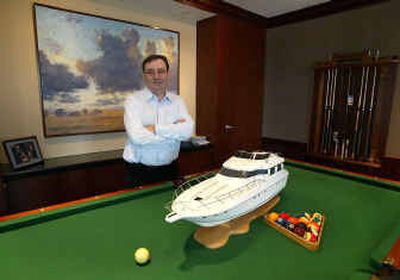Making waves

LAKE FOREST, Ill. — A handcrafted, vintage-1880 pool table adorns the executive suite at Brunswick Corp. headquarters, emblematic of the company’s roots.
The elegant table stands cluttered with papers, however, and CEO George Buckley has never shot a game on it. He’s preoccupied with plotting Brunswick’s next course on the water.
Founded on billiards and best-known for bowling, Brunswick Corp. is a fast-expanding power in the boating business. From runabouts to cruisers to $10 million yachts and the engines that power them, the company gained more than 80 percent of its $5.2 billion in sales last year from boats and marine engines.
What’s really drawing attention lately, though, is Brunswick’s aggressive strategy as it tries to reshape an industry that has seen millions of boaters quit the pastime since the 1990s.
The 160-year-old company, which didn’t get into boating until the ripe age of 115, has been buying up boat and engine brands and suppliers and trying to extend its influence to all parts of the business.
In the past year, Brunswick has scooped up seven brands — including such well-known names as Lund and Sea Pro — to leapfrog Genmar Holdings Inc. as the world’s largest manufacturer of recreational boats. Those acquisitions followed the 2003 purchases of Land ‘N’ Sea and Attwood, top marine parts suppliers.
More deals are envisioned as Brunswick, which makes more than 130,000 boats a year, barrels ahead with an ambitious strategy it unabashedly calls “cover the waterfront.”
“What that means is we want to be in engines and boats, we want to be in related services, we want to be in marina management,” Buckley said in an interview. “We want to be essentially everywhere the consumer is spending money.”
Brunswick’s Bayliner operation once had a manufacturing plant in Spokane, which now is closed, said a spokesman, but the company still has “significant operations” in Arlington, Wash. Brunswick makes Bayliner, Maxum, Trophy and Meridian boats and yachts there, the spokesman said.
Buckley, a fifth-year CEO, aspires to make his company the Toyota of the boating industry — selling well-engineered products at every price level and every market, backed by a powerful dealer network and service for boat owners after sales are completed.
As part of its push into every aspect of boating, Brunswick is even creating a used-boat business.
Analysts largely endorse the company’s expensive strategy. Brian Rayle of FTN Midwest Research sees it as benefiting customers by offering an integrated product that might make it easier for them to pursue their hobby, and bringing more efficiency to the boating business in general.
“Boat manufacturing had been a cottage industry,” he said. “They’re adding the scale to it that the industry really needs.”
But Brunswick’s quest for dominance has perhaps inevitably thrown a scare into independent builders and suppliers and made many dealers uneasy about devoting their loyalties to a single company.
The United Marine Manufacturers Association, the largest organization of independent boat builders, has urged its members to avoid buying the company’s products because “Brunswick intends to put you out of business.” Group president Kent Wooldridge likens the big manufacturer to Wal-Mart with its growing presence and clout.
“We would have no issue with Brunswick if they would split off their power (engine) company from their boat company and simply conduct business on a level playing field,” he said.
No one disputes Brunswick is on a roll. After being hurt by the recession that damped consumer demand from 2000-03, the company outpaced the industry last year with a 16 percent sales jump, excluding acquisitions. Profits doubled to $270 million.
The gains came despite the fact the estimated number of 72 million U.S. boaters is flat compared with 15 years ago and down more than 6 million from its 1997 peak, according to the National Marine Manufacturers Association. Sales are now climbing again as boats get bigger and fancier, thanks largely to affluent baby boomers.